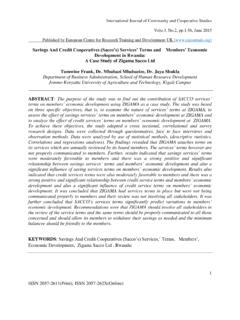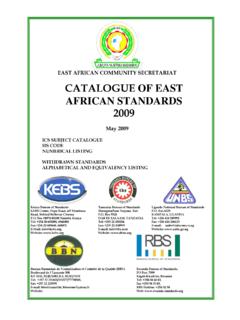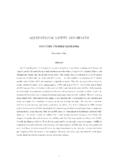Transcription of TANZANIA REVENUE AUTHORITY - SANEC
1 1 TANZANIA REVENUE AUTHORITY TAXATION IN TANZANIA THE TANZANIA INVESTMENT AND TRADE PROMOTION INTRODUCTION Tax administration in TANZANIA has a three-tier structure, namely Central Government tax administration, tax administration in Zanzibar and Local Governments tax administration. The TANZANIA REVENUE AUTHORITY (TRA) administers the Central Government taxes; Zanzibar REVENUE Board administers domestic consumption taxes in Zanzibar, while the Local Authorities administer the various local imposts. Central Government taxes are the major REVENUE earner for the Government, accounting for about 90% of domestic REVENUE . THE TAX STRUCTURE The Central Government taxes comprise direct and indirect taxes. The direct taxes account for around 30% of total tax REVENUE , while the indirect taxes account for around 70% of total tax REVENUE .
2 Direct taxes include the personal income taxes (PIT), corporate income tax (CIT) and withholding taxes on business, capital and investment incomes. The indirect taxes comprise taxes on international trade transactions and on domestically produced goods and services, namely the value added tax, excises and import duties. The tax base and rate structure of the Tanzanian tax system has been rationalized and streamlined with a view to instituting a fair, simple, equitable, efficient and taxpayer/investor-friendly tax regime. A number of nuisance taxes have been abolished, the regulatory framework has been harmonized, an incentive regime has been put in place and the rates have been gradually reduced. To attract investment the Government has abolished protectionist excises, replaced the 2 distortionary sales tax with value added tax and removed a two-tier corporate tax that provided for a reduced rate for residents and higher rate for non-residents for a single rate.
3 Most rates are now in line with the internationally accepted best practice, requiring no more than fine-tuning. Corporate tax rate is 30%, while VAT is chargeable on goods and services at 18%. There are also specific-rate excises on mostly traditional excisable products viz. tobacco, alcoholic drinks, soft drinks, films and music products and petroleum products while ad-varolem-rates are on non-utility motor vehicles and mobile phone service. Two non-zero import duty rates at 10% and 25% are applicable under EAC Customs Union on importation of goods and services, depending on Customs classification codes, but raw materials and capital goods are zero-rated. Withholding taxes on business and capital incomes such as dividends, interest and royalties are also applicable at the rates ranging between 10% to 20%.
4 The tax rates for selected tax sources in TANZANIA are as shown on the following Tables below: 3 B. INDIRECT TAXES 3. Value Added Tax (VAT) VAT Registration Threshold: Taxable turnover exceeding sh. million per annum. VAT Rates Supply of taxable goods and services in Mainland TANZANIA 18 % Importation of taxable goods and services into Mainland TANZANIA 18% Export of goods and certain services from United Republic of TANZANIA 0% Supply of taxable goods and services to relieved persons 0% THE TAX ADMINISTRATION In order to effectively and efficiently implement fiscal policy the Government during 1995/96 established an autonomous REVENUE administration, the TANZANIA REVENUE AUTHORITY (TRA), charged with the assessment, collection and accounting of Central Government revenues. Since then, TRA has to a larger extent increased the A.
5 DIRECT TAXES RATES TAX SOURCE RESIDENT NON-RESIDENT 1. Corporate Tax o Total Income of domestic permanent establishment o Repatriated Income of branch 30% N/A 30% 30% 10% 2. Withholding Tax on: Dividends to company controlling 25% shares or more. Dividends from DSE listed company Interest Royalties Technical services (mining) 0% 5% 10% 15% 5% 10% 5% 10% 15% 15% 4 efficiency, effectiveness and transparency in REVENUE administration, features that were lacking under the regime that was replaced. Under the new tax administrative arrangement the government has achieved 00significant transformation in REVENUE mobilization through initiating several administrative measures aimed at streamlining it, modernizing systems and removing inefficiencies. The United Republic of TANZANIA Constitution recognizes the two parties of the union, namely Zanzibar and the Mainland TANZANIA .
6 As such, the Constitution has identified union taxes and non-union taxes. While TANZANIA REVENUE AUTHORITY collects the Union taxes, the Zanzibar REVENUE Board collects all non-union taxes in Zanzibar. Taxes on income imposed under the Income Tax Act 2004 and custom duties under the East African Customs Management Act 2004 are union taxes, whereas domestic consumption taxes including the Value Added Tax, Excise Duties, hotel levies, stamp duties, motor vehicles taxes, and other charges are non-union taxes. REVENUE ADMINISTRATION MODERNIZATION INITIATIVES In order to have a taxpayer/investor friendly environment to REVENUE mobilization the TANZANIA REVENUE AUTHORITY is implementing a Fourth 5-year Corporate Plan, envisioning itself to increase REVENUE to GDP ratio to by the year 2018. A modernized tax administration is one that has a strong enforcement capacity delivered by highly qualified, motivated and committed staff.
7 The focus of the Fourth TRA Corporate Plan is to make it investor- and taxpayer-friendly machinery as well as ensure collection of REVENUE efficiently to capacity level. The Corporate Plan is based on the three strategic themes of Convenience, compliance and continual improvement by facilitating taxpayers obligations. In a nutshell, the characteristic features of modernizing tax administration in TANZANIA include Integration of Income Tax and VAT operations, Customs Modernization, creating and interfacing systems, reforming refunds systems and putting in place a stakeholders forum. 5 Strategic Themes Convenience The focus of this theme is to deliver cost-efficient, consistent and reliable services to taxpayers. This entails the streamlining of processes, optimization of automation opportunities for self-service in order to contribute to shorter service turn around times and prompt service delivery.
8 Compliance Taxpayer segmentation facilitates better allocation of administrative resources and risk-management approaches to compliance. Large, medium and small taxpayers offer very different REVENUE opportunities and compliance challenges. A comprehensive taxpayer compliance strategy that takes into account the compliance capacity of taxpayer segments, the internal capacity of TRA particularly on the use of ICT and international best practice will address specific compliance issues for each segment. Continual Improvement A tax administration is not static hence there is a need to build effective models for on- going organisational change. Continual improvement initiatives focusing on cultural change and integration of operations to minimise administrative costs implemented. A culture of innovation will be developed within the organisation to motivate new ideas for improvement of TRA operations, building coalitions with external stakeholders, developing an internal performance culture that is receptive to change and supported by capable leadership that adheres effectively to good governance requirements and is clear on its mandate and accountabilities.
9 Reforming refunds systems In order to improve efficiency in tax refunds repayment claims, all claims are now classified into three categories namely, gold, silver and non-gold silver. The gold category covers regular payment traders who 6 meet the qualifying criteria and their claims are settled within 30 days from the date of lodgment. The Silver category is for regular payment traders not meeting the gold criterion. Claims are settled within 30 days from the date of lodgment for two consecutive claims but full-scale audit is prerequisite for the third claim settlement. The non-gold silver category is for the claimants who require thorough audit before affecting their refund claims. We trust that this system will to a very large extent solve the problem of delayed tax refunds. Already we are refunding 92% of correct claims within 30 days.
10 Stakeholders Forum The government has established a round table dialogue with its stakeholders to discuss issues of interest pertaining to taxes for the betterment of all parties. Under this system, all major tax reforms are discussed for the purpose of clearing stakeholders doubt and take their views on board if seen appropriate. So far several stakeholders meetings have been held and in most cases the meetings end up in harmony. TAX INCENTIVES TANZANIA recognizes the importance of investment to stimulate economic growth and create a potential for a sustainable future REVENUE generation. Consequently, the government has offered a tax incentive regime conducive to investment provided for in the various tax statutes, the Income Tax Act of 2004, Value Added Tax Act of 1997 and the East African Customs Management Act 2004.







